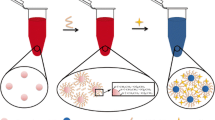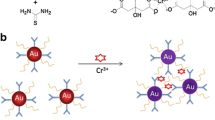Abstract
A low-cost and environment-friendly sensor was developed for visual determination of gold ions (Au3+) by using label-free hydrogen doped molybdenum oxide (H0.3MoO3) nanoparticles as ratio probes. According to the characterization results of transmission electron microscopy, scanning electron microscopy, X-ray powder diffraction, and Fourier transform infrared spectra, Au3+ is easily reduced to red Au nanoparticles (AuNPs) by blue H0.3MoO3 nanoparticles. The color change of the solution depends on the concentration of Au3+, which makes it possible to detect Au3+ visually. Under optimal experimental conditions of pH 4.6, H0.3MoO3 nanoparticles concentration of 0.075 mg·mL−1, and reaction time of 7 min, the sensor offers a satisfactory determination range from 0.5 to 70 μM and a good determination limit of 0.45 μM for Au3+. The concentration of Au3+ as low as 10 μM can be directly distinguished through the naked eye. Additionally, the colorimetric probe has also been proved applicable in environmental water samples. More importantly, the resulting AuNPs have good stability and oxidase-like activity, which may be directly used in sensing, catalysis, energy, and other fields.
Graphical Abstract





Similar content being viewed by others
References
Cao X, Li C, Lu Y et al (2019) Catalysis of Au nano-pyramids formed across the surfaces of ordered Au nano-ring arrays. J Catal 377:389–399
Chen Y, Pan R, Wang Y et al (2022) Carbon helical nanorobots capable of cell membrane penetration for single cell targeted SERS bio-sensing and photothermal cancer therapy. Adv Funct Mater 32:2200600
Zhao YQ, Sun Y, Zhang Y et al (2020) Well-defined gold nanorod/polymer hybrid coating with inherent antifouling and photothermal bactericidal properties for treating an infected hernia. ACS Nano 14:2265–2275
Huang X, Zhang Z, Chen L et al (2022) Multifunctional Au nano-bridged nanogap probes as ICP-MS/SERS dual-signal tags and signal amplifiers for bacteria discriminating, quantitative detecting and photothermal bactericidal activity. Biosens Bioelectron 212:114414
Shen J, Xiao Q, Sun P et al (2021) Self-Assembled Chiral Phosphorescent Microflowers from Au Nanoclusters with Dual-Mode pH Sensing and Information Encryption. ACS Nano 15:4947–4955
He Y, Liang Y, Wang D (2015) Highly sensitive and facile colorimetric detection of glycidyl azide polymer based on propargylamine functionalized gold nanoparticles using click chemistry. Chem Commun 51:12092–12094
Ingo O (2009) On the medicinal chemistry of gold complexes as anticancer drugs. Coordin Chem Rev 253:1670–1681
Li M, Wang Q, Shi X et al (2011) Detection of mercury(II) by quantum Dot/DNA/gold nanoparticle ensemble based nanosensor via nanometal surface energy transfer. Anal Chem 83:7061–7065
Tang R, Sun H, Zhang Z et al (2022) Incorporating plasmonic Au-nanoparticles into three-dimensionally ordered macroporous perovskite frameworks for efficient photocatalytic CO2 reduction. Chem Eng J 429:132137
Kumeria T, Santos A, Losic D (2013) Ultrasensitive nanoporous interferometric sensors for label-free detection of gold (III) Ions. ACS Appl Mater Interfaces 5:11783–11790
Yang Y, Yin C, Huo F, Chao J (2013) A selective fluorescent probe for detection of gold(III) ions and its application to bioimaging. RSC Adv 3:9637–9640
Wang Q, Feng Y, Jiang J et al (2016) A coumarin-based colorimetric and fluorescent probe for the highly selective detection of Au3+ ions. Chinese Chem Lett 27:1563–1566
Liu S, Pan X, Zhu J (2021) A facile strategy to construct versatile fluorescent probes for the detection of Au3+ and nitroaromatic. React Funct Polym 167:105017
Losev VN, Parfenova VV, Elsuf’ev EV et al (2019) Separation and preconcentration followed by ICP-OES and ICP-MS determination of precious metals using silica gel chemically modified with dithiocarbamate groups. Sep Sci Technol 55: 2659-2669.
Wang Z, Li X, Liang H et al (2017) Equilibrium, kinetics and mechanism of Au3+ Pd2+ and Ag+ ions adsorption from aqueous solutions by graphene oxide functionalized persimmon tannin. Mat Sci Eng C-Mater 79:227–236
Zhang JF, Zhou Y, Yoon J, Kim JS (2011) Recent progress in fluorescent and colorimetric chemosensors for detection of precious metal ions (silver, gold and platinum ions). Chem Soc Rev 40:3416–3429
Li X, Hu Q, Yang K, al e (2022) Red fluorescent carbon dots for sensitive and selective detection and reduction of Au3+. Sensor Actuat B-Chem 371:132534
Hao G, Yasutaka K, Hiromi Y (2022) Development of defective molybdenum oxides for photocatalysis, thermal catalysis, and photothermal catalysis. Chem Commun 58:8466–8479
Dongwook K, Mengjing W, Kristie JK et al (2019) Molybdenum trioxide (α-MoO3) nanoribbons for ultrasensitive ammonia (NH3) gas detection: integrated experimental and density functional theory simulation studies. ACS Appl Mater Interfaces 11:10697–10706
Pei-Hua L, Zong-Yin S, Meng Y et al (2020) Electrons in oxygen vacancies and oxygen atoms activated by Ce3+/Ce4+ promote high-sensitive electrochemical detection of Pb(II) over Ce-doped α-MoO3 catalysts. Anal Chem 92:16089–16096
Rui L, Hongjie A, Wei H, Yi H (2018) Molybdenum oxide nanosheets meet ascorbic acid: tunable surface plasmon resonance and visual colorimetric detection at room temperature. Sensor Actuat B-Chem 259:59–63
Zhang BY, Zavabeti A, Chrimes AF et al (2018) Degenerately hydrogen doped molybdenum oxide nanodisks for ultrasensitive plasmonic biosensing. Adv Funct Mater 28:1706006
Li R, Wang J, He Y, Dong F, Bian L, Li B (2019) Mechanochemical synthesis of defective molybdenum trioxide, titanium dioxide, and zinc oxide at room temperature. ACS Sustainable Chem Eng 7:11985–11989
Wang J, Li H, Yu H, He Y (2020) Room temperature preparation of surface-clean hydrogen-doped plasmonic molybdenum oxide as a high-efficient and degradable reactive oxygen species scavenger. Plasmonics 15:1827–1833
Liyan X, Qing Z, Guozhen Z et al (2020) Tunable hydrogen doping of metal oxide semiconductors with acid-metal treatment at ambient conditions. J Am Chem Soc 142:4136–4140
Huang W, Wang J, Du J, Deng Y, He Y (2019) Contrary logic pairs and circuits using a visually and colorimetrically detectable redox system consisting of MoO3-x nanodots and 3,3′-diaminobenzidine. Microchim Acta 186:79
Cao S, Jiang J, Tian Q et al (2022) Building of multifunctional and hierarchical HxMoO3/PNIPAM hydrogel for high-efficiency solar vapor generation. Green Energy Environ 7:1006–1013
Xiaojing Y, Yingying W, Jingjing X, Mei-Xia Z (2021) A multifunctional carbon dots with near-infrared fluorescence for Au3+/Hg2+ and GSH detection and tumor diagnosis. Microchem J 165:106033
Wenli G, Haohan S, Xiao W et al (2018) Carbon dots with red emission for sensing of Pt2+, Au3+, and Pd2+ and their bioapplications in vitro and in vivo. ACS Appl Mater Interfaces 10:1147–1154
Bholanath D, Sk N, Maidul H, Pallab P, Ananta Kumar A (2019) A triazole linked C-glycosyl pyrene fluorescent sensor for selective detection of Au3+ in aqueous solution and its application in bioimaging. Sensor Actuat B-Chem 279:476–482
Kananat N, Narongpol K, Weekit S, Khomson S (2023) A novel indolino-spironaphthooxazine as the highly sensitive and selective probe for colorimetric detection of Au3+. Dyes Pigments 214:111193
Waroton P, Mongkol S, Mamoru T, Anawat A (2023) A Dihydropyridine derivative as a highly selective fluorometric probe for quantification of Au3+ residue in gold nanoparticle solution. Sensor 23:436
Wanhe W, Jianhua L, Lingtan K (2023) Synthesis and luminescence monitoring of iridium(III) complex-functionalized gold nanoparticles and their application for determination of gold(III) ions. Microchim Acta 190:171
Tao Y, Ju E, Ren J, Qu X (2015) Bifunctionalized mesoporous silica-supported gold nanoparticles: intrinsic oxidase and peroxidase catalytic activities for antibacterial applications. Adv Mater 27:1097–1104
Funding
The support of this research was from the Foundation of Science and Technology Department of Sichuan Province (Grant No. 2022YFG0134) and Talent Program of Sichuan University of Science & Engineering (Grant No. E10402736).
Author information
Authors and Affiliations
Contributions
Wei Huang: investigation, methodology, writing - review & editing. Long Wang: investigation, methodology, validation. Dengying Long: investigation, writing - original draft. Xiaonan Liu: project administration.
Corresponding authors
Ethics declarations
Conflict of interest
The authors declare that they have no competing of interests.
Additional information
Publisher’s note
Springer Nature remains neutral with regard to jurisdictional claims in published maps and institutional affiliations.
Supplementary information
ESM 1
The online version contains supplementary material available at https://doi.org/. (DOCX 4274 kb)
Rights and permissions
Springer Nature or its licensor (e.g. a society or other partner) holds exclusive rights to this article under a publishing agreement with the author(s) or other rightsholder(s); author self-archiving of the accepted manuscript version of this article is solely governed by the terms of such publishing agreement and applicable law.
About this article
Cite this article
Huang, W., Wang, L., Long, D. et al. Colorimetric determination and recycling of gold(III) ions using label-free plasmonic H0.3MoO3 nanoparticles. Microchim Acta 190, 245 (2023). https://doi.org/10.1007/s00604-023-05826-8
Received:
Accepted:
Published:
DOI: https://doi.org/10.1007/s00604-023-05826-8




